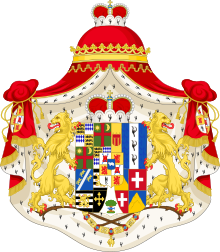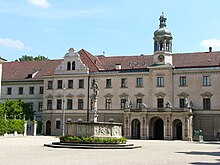Type a search term to find related articles by LIMS subject matter experts gathered from the most trusted and dynamic collaboration tools in the laboratory informatics industry.

The Princely House of Thurn and Taxis (German: Fürstenhaus Thurn und Taxis, [ˈtuːɐ̯n ʔʊnt ˈtaksɪs]) is a family of German nobility that is part of the Briefadel. It was a key player in the postal services in Europe during the 16th century, until the end of the Holy Roman Empire in 1806, and became well known as the owner of breweries and commissioner of several castles. The family has resided in Regensburg since 1748 with their seat at St. Emmeram Castle from 1803. The family is one of the wealthiest in Germany, and the current head of the House is Albert, 12th Prince of Thurn and Taxis.
They are one of the mediatised Houses for their former Sovereign Imperial counties, later mediatised to Kingdom of Württemberg (Buchau Princely Abbey, now Bad Buchau), Kingdom of Bavaria and Hohenzollern-Sigmaringen.
County of Thurn and Taxis Grafschaft Thurn und Taxis | |||||||
|---|---|---|---|---|---|---|---|
| 1608–1806 | |||||||
| Status | State of the Holy Roman Empire | ||||||
| Capital | Regensburg | ||||||
| Government | Principality | ||||||
| Historical era | Early modern period | ||||||
• Raised to Briefadel | 1512 | ||||||
• Raised to Reichsfreiherren | 1608 | ||||||
• Hereditary Imperial Postmaster General | 1615 | ||||||
• Raised to County | 1624 | ||||||
• Granted princely rank (Spanish Court) | 1681 | ||||||
| 1695 | |||||||
• Mediatised to Bavaria | 1806 | ||||||
• Postal monopoly nationalised | 1867 | ||||||
| |||||||
The Tasso family (from the Italian word for "badger", the family's heraldic animal) was a Lombard family in the area of Bergamo. The earliest records place them in Almenno in the Val Brembana around 1200,[1] before they fled to the more distant village of Cornello to escape feuding between Bergamo's Colleoni (Guelf) and Suardi (Ghibelline) families. Around 1290,[2] after Milan had conquered Bergamo, Omodeo Tasso organized 32 of his relatives into the Company of Couriers (Compagnia dei Corrieri) and linked Milan with Venice and Rome.[3] The recipient of royal and papal patronage, his post riders were so comparatively efficient that they became known as bergamaschi throughout Italy.[4]
Ruggiero de Tassis was named to the court of the Emperor Frederick the Peaceful in 1443. He organized a post system between Bergamo and Vienna by 1450;[2] from Innsbruck to Italy and Styria around 1460; and Vienna with Brussels around 1480.[2] Upon his success, Ruggiero was knighted and made a gentleman of the Chamber.[4][5] Janetto von Taxis was appointed Chief Master of Postal Services at Innsbruck in 1489. Philip of Burgundy elevated Janetto's brother Francesco I de Tassis to captain of his post in 1502.[6] Owing to a payment dispute with Philip, Francisco opened his post to public use in 1506.[2] In 1512 the family was ennobled by Emperor Maximilian I.[7] By 1516, Francisco had moved the family to Brussels in the Duchy of Brabant, where they became instrumental to Habsburg rule, linking the rich Habsburg Netherlands to the Spanish court.[6] The normal route passed through France, but a secondary route across the Alps to Genoa was available in times of hostility.
At the death of Francisco in 1517, Emperor Charles V appointed Francisco's nephew Johann Baptista von Taxis (1470-1541) as Generalpostmeister of the Kaiserliche Reichspost. Johann Baptista was briefly succeeded by his eldest son, Franz II von Taxis (1514-1543), after whose untimely death the family split into two further branches. The youngest son, Leonhard I von Taxis, succeeded as Generalpostmeister and is the ancestor of the princely Thurn and Taxis family. Johann Baptista's second-eldest son, Raymond de Tassis (1515-1579), took over the office of postmaster-general to the Crown of Spain and settled in Spain. Raymond married into Spanish nobility, and his eldest son Juan de Tassis was created Count of Villamediana in 1603 by Phillip III. The Spanish line of the family became extinct with Juan de Tassis, 2nd Count of Villamediana, a poet who died in mysterious circumstances in 1622.[8]
In 1608 the Brussels line was raised to the status of hereditary barons, and in 1642 the Innsbruck line as well (which descends from Gabriel de Tassis, d. 1529). When the Brussels line was raised to the hereditary status of counts in 1624, they needed illustrious lineage to legitimize their intended further ascension to the high nobility. Alexandrine von Taxis commissioned genealogists to "clarify" their origin, who until then had only been considered a family descending from medieval knights who had become merchants. They now claimed, albeit without documentary evidence, that they descended from the Italian noble family Della Torre, or Torriani, who had ruled in Milan and Lombardy until 1311. She then applied to the emperor for a name change. With the Germanization, the coat of arms symbol of the Milanese family, the tower (Torre), became Thurn (an older German spelling, nowadays Turm) and was placed in front of the actual family name Tasso, translated with Taxis (an older German spelling for Dachs = Badger). The tower of the Torriani was added to the badger as a coat of arms.[9] They formally adopted the German form of their name in 1650, including the comital Innsbruck line, which also exists to this day.
In 1681 the Brussels line was elevated to the Spanish Netherlands' rank of prince with Eugen Alexander Franz, 1st Prince of Thurn and Taxis, with Braine-le-Château (acquired in 1670) as his titular principality (Principauté de la Tour et Tassis), and in 1695 to the rank of imperial prince at the behest of Emperor Leopold I, although at that time no territorial possessions existed in the Holy Roman Empire. Admission to the Imperial Council of Princes in the Imperial Diet took place in 1704.[10]
The Brussels line moved to Frankfurt in 1703 because of the War of the Spanish Succession; their new family seat built from 1731 was the Palais Thurn und Taxis. Emperor Charles VII appointed Alexander Ferdinand, 3rd Prince of Thurn and Taxis, Principal Commissioner (Lord Chancellor) of the Imperial Diet in 1743. He therefore moved to Regensburg, where the parliament was seated, in 1748. The position became hereditary in the family who lived in different houses there, but the company headquarters remained in Frankfurt. When Saint Emmeram's Abbey in Regensburg was secularized in 1803, the monastery buildings were donated to the princes of Thurn and Taxis, who had them converted into a residence, henceforth known as Schloss Thurn and Taxis, sometimes also called Saint Emmeram Palace. It has remained their family seat to this day.[11]
In 1786, Karl Anselm, 4th Prince of Thurn and Taxis, acquired the Upper Swabian county of Friedberg with the lordships of Scheer, Dürmentingen and Bussen from the princes of Waldburg, which from 1787 was known as the County of Friedberg-Scheer. Only then did the Thurn und Taxis rule their own principality of the empire for 20 years, but their main source of income remained the Imperial Reichspost.
The family operated the Thurn-und-Taxis Post, successor to the Imperial Reichspost of the Holy Roman Empire, between 1806 and 1867. Their postal service was gradually lost over the centuries, with the Spanish network being bought by the crown in the 18th century and the German post being purchased by Prussia after the fall of the Free City of Frankfurt in 1866. By investing their earnings from the postal business - later also the settlements for the postal rights - in numerous landed estates, a large number of forests and farms as well as castles were added to the family property, especially from secularized church property, among them Buchau Abbey, Marchtal Abbey, Neresheim Abbey, Ennetach Abbey, Siessen Abbey, and others. In 1803 they were summarized as Imperial Principality of Buchau.[12] The buildings of these monasteries were mostly re-donated to the church in the 20th century, but the lands continue to be cultivated by the princely administration. Besides the St Emmeram's Palace the current prince still owns Taxis Castle (Trugenhofen) and Garatshausen Castle at Feldafing on Lake Starnberg.

Rainer Maria Rilke wrote his Duino Elegies while visiting Princess Marie of Thurn and Taxis (née Princess of Hohenlohe, wife of Prince Alexander) at her family's Duino Castle. Rilke later dedicated his only novel (The Notebooks of Malte Laurids Brigge) to the princess, who was his patroness. Her son Prince Alexander (1881–1937) became an Italian citizen named Principe della Torre e Tasso and was raised in 1923 by the Italian king to Duke of Castel Duino. Today Duino Castle belongs to his grandson, Prince Carlo della Torre e Tasso, Duca di Castel Duino (b. 1952). The Duino branch is part of the family's Czech branch that in the early 19th century settled in Bohemia (now the Czech Republic).
Several members of the family have been Knights of Malta.
Until 1919, the titles of the head of the princely house were His Serene Highness the Fürst von Thurn und Taxis, Prince of Buchau and Prince of Krotoszyn, Duke of Wörth and Donaustauf, Princely Count of Friedberg-Scheer, Count of Valle-Sássina, Marchtal, Neresheim etc., Hereditary Postmaster General.[13]
The current head of the house of Thurn and Taxis is Albert II, 12th Prince of Thurn and Taxis, son of Johannes and his wife, Gloria. The family is one of the wealthiest in Germany. The family's brewery was sold to the Paulaner Group of Munich in 1996, but it still produces beer under the brand of Thurn und Taxis.
| House of Thurn und Taxis |
|---|
 |
| Extended family |
|
The Thurn and Taxis family came to massive media attention during the late 1970s through mid-1980s when Prince Johannes married Countess Mariae Gloria of Schönburg-Glauchau, a member of an impoverished but mediatized noble family. The couple's wild, "jet set" lifestyle and Princess Gloria's over-the-top appearance (characterized by bright hair colours and avant-garde clothes) earned her the nickname of "Princess TNT".[14]